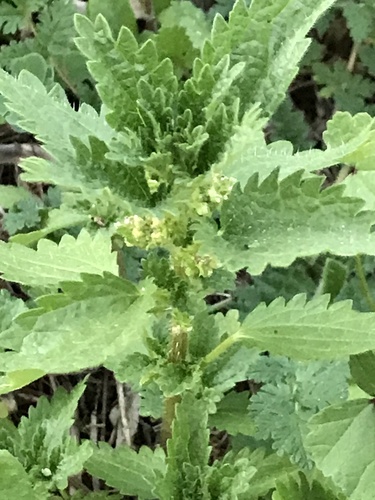Observations of the Month: Stinging Nettles (Urticaceae)
Dwarf Nettle (Urtica urens)
https://www.inaturalist.org/observations/70230358 by @andyjones1
Hoary Nettle (Urtica dioica ssp. holosericea)
https://www.inaturalist.org/observations/54278783 by @docprt
Western Nettle (Hesperocnide tenella)
https://www.inaturalist.org/observations/42434757 by @kmerrill
The plants featured this month are armed with specialized hairs filled with an irritating chemical solution which can be injected into the skin of unsuspecting observers who touch the stems or leaves. This group of plants have opposite leaves that are toothed. Their flowers are not showy: they have no petals and are small. All three plants prefer moist soils and can be found in much of the county, excluding the desert. Despite their similarities, you can tell these nettles apart by several characteristics.
Unlike the other two, Dwarf Nettle is an introduced species from Europe. It is an annual which is often found in disturbed areas, parks, and gardens, and grows only to about 2 feet in height.

Dwarf Nettle by Andy Jones
Dwarf Nettle has clustered flowers arising from leaf axils, projecting only a short distance away from the stem (usually less than the length of the leaf’s petiole) which may appear as early as January until about April. It is the most common of the three and can be found from the coast inland to an elevation of about 3,200 feet.
Hoary Nettle is a native perennial found in moist meadows and along the edges of streams, lakes, and other waterways. In addition to its stinging hairs, Hoary Nettle may have dense soft non-stinging hairs on its stems and the underside of leaves.

Hoary Nettle by Peter R. Thomas
It is a much larger plant than the other two nettles, growing from about 3 to 10 feet tall. Its leaves are larger and often folded along the midvein. The flowers of Hoary Nettle are more loosely arranged as a spike or panicle, extending from the stem often as far as the leaf tips, and are usually present from about June to September. Although it can be found in coastal San Diego, Hoary Nettle is more common in our mountains, and is the only one of the three to regularly occur above 3,500 feet.
Western Nettle is the least common of the three and perhaps the most distinctive, with stems that are often red and leaves that are adorned with black dots at the base of the stinging hairs and rounded teeth.

Western Nettle by Karen Merrill
Its flowers are arranged in spherical clusters close to the stem and are present from about February to June. This native annual is the smallest of the three, growing to about 18 inches tall. It is often found in shaded areas, such as at the base of rocks or shrubs. It is found from the coast to the foothills, including at elevations somewhat higher than Dwarf Nettle, but not as high as Hoary Nettle.
Be sure to visit the San Diego County Plant Atlas website to find additional resources to help you identify the Stinging Nettles and other plants.




